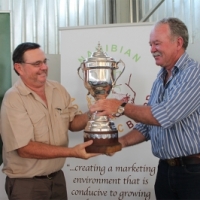
Sikondo reaps NAB maize award
The Namibian Agronomic Board’s title of Master Agronomist 2015 has been awarded to Mr Hendrik (Rustie) Kleynhans of Sikondo, a Government Irrigation Project 12km west of Rundu. The Namibian Agronomic Board (NAB) has been awarding commercial producers of white maize for the past 15 years. The purpose of the award is to recognise the outcomes and results of the holistic farming approach of producers of white maize under irrigation as well as rain fed conditions in the Republic if Namibia. “The Master Agronomist Award is much more than just awarding quantity in production, “said Mr Christof Brock, CEO of the NAB at the award ceremony, “it is about farmers understanding what they do, why they do it and the innovations that they apply to their farming practices to overcome challenges in realising successful crops,” he added. Awarding the Master Agronomist title annually forms part of the NAB’s mandate of creating a marketing environment in Namibia that is conducive to the growing and processing of locally produced crops. The award was bestowed upon Kleynhans during the Annual General Meeting of the Namibian Agricultural Union at Sikondo.
This year, the award is for a crop produced under irrigation. Situated on the outskirts of Rundu on the road to Nkurenkuru, Sikondo is a modern beacon that spans 800ha. Even to the untrained eye, the regimented fields of rain fed white maize and mahangu, the pivot sprayers leaning over irrigated crops, the silos and storage sheds, the well maintained farming equipment and the process and order imposed on the farming operation speaks to the intent of maximising yield with careful consideration and utilisation of the available resources at Sikondo. Of the 800ha production area, 600ha is under irrigation:
480ha is under 20 centre pivots
70ha under draglines
54ha under micro irrigation
Between 50 and 60 ha of the produce at Sikondo is cultivated under rain fed conditions.
Sikondo Irrigation Project falls under the Ministry of Agriculture, Water and Forestry’s Green Scheme Project strategy “to attract and enable large scale commercial farming enterprises to establish commercially viable entities in remote undeveloped rural areas to act as service providers for the successful and sustainable settlement of small scale farmers”. Sikondo has only been producing for three years and is made up of two farms where medium scale producers work the eastern side of the land and commercial scale producers work the western side. The new Master Agronomist spoke about the increasing pressures of the input costs of running a successful operation, “To run a farm is not easy,” he said, “to make it profitable is one thing because as everyone knows, the input costs get higher and higher every year.” One of the main farming challenges at Sikondo is the characteristic white, grey and red soils of the Kavango Region. “The soil is very poor here,” Kleynhans told the gathering of his peers, “it is very sandy and has little phosphates and we are in the process of trying to bring in up to 1 000 tonnes of cattle manure onto the farm to upgrade the carbon content in the soil.” At present a focus area at Sikondo is to improve the fertility of the soils so that the farm can keep producing effectively, a move that is in line with the vision of the Green Scheme Project of improving and maintaining the land production capability to achieve food security in the Republic of Namibia. Kleynhans acknowledged the support and the sizable investment made by the Ministry of Agriculture, Water and Forestry and highlighted the individual inputs from Agribusdev and the Agro Marketing and Trade Agency (AMTA). He also acknowledged and thanked his staff for their roles and contributions in making Sikondo the production area that it has become.
The Sikondo Irrigation Project is diverse and a tour of the development of the farm under Kleyhans’s leadership demonstrates considerable success at producing not only grains, but potatoes and butternuts, two crops that will be harvested in the near future. The farm also produces onions and is in the process of erecting four half hectares of shade nets for the production of soft vegetables.
